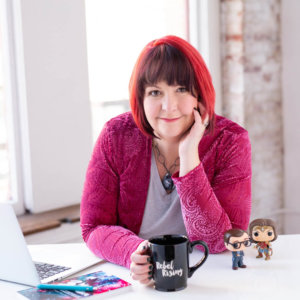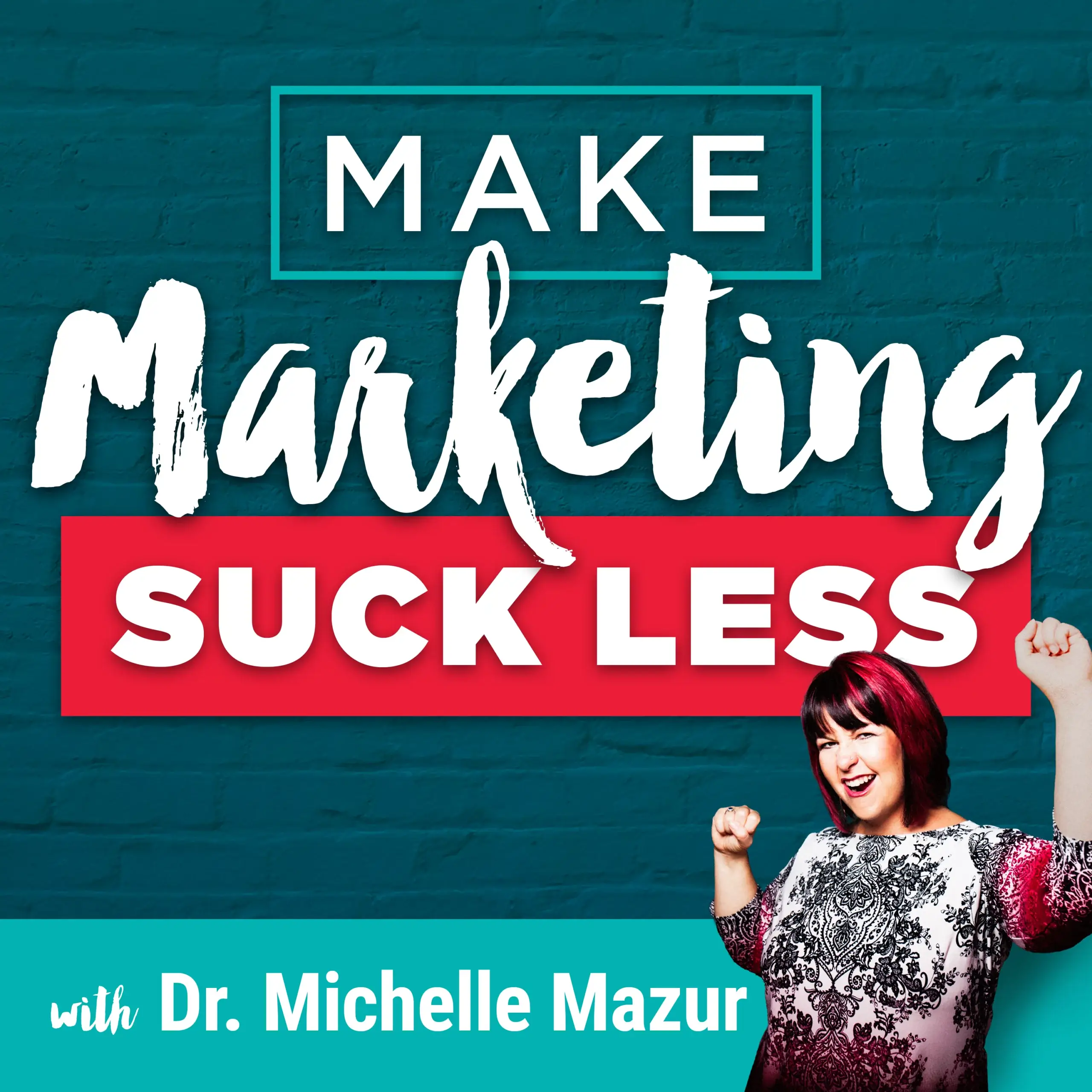Make Marketing Suck Less
Direct Your Audience to Act with BOLD Direction
By Michelle Mazur > June 30, 2020
Filed Under Podcast

Today we're finishing up the BOLD Thought Leadership Framework with D and direction. But first, let's recap what we've learned so far about the framework.
- B: Be the only by claiming what you're the best at (episode here).
- O: Be other focused, because your thought leadership, your leadership is for other people and we have to be focused on them and create a place of self reflection (episode here).
- L: This stands for leadership. L is all about leading with our values, our viewpoints and our frameworks (episode here).
Direction is the next logical step, because as a leader, you have provide your audience direction. One of the biggest mistakes you can make in your business is just assuming that your audience knows what you want them to do.
You will most often do this through a call to action, a clear way to say what you need them to do from your marketing. This is that missing link, the thing that makes the connection for your audience between marketing and sales.
However, there's a few golden rules to writing effective calls to action, and that's exactly what we're going to be covering today on the show.
Remember, being bold means claiming what you’re the best in the world at so that you can be the only, it means being other focused so that you can serve and change them. It is about leadership and leading people with your values, with your viewpoints, and with your frameworks, and it's about direction. It's giving people direction about the next step to take.
Table of Contents
- 1 This is why the final letter in the bold thought leadership framework is D for direction as a thought leader, or as a leader, you've got to provide direction.
- 2 So part of doing that is first understanding what you want your people to do.
- 3 Your ask or the direction you're giving your call to action is always based on the kind of relationship that you've developed with your audience.
- 4 All right, finally, this is very important. You only want to give one direction at a time, make one ask at a time, because a confused mind never buys.
Tune in or read through the transcript below
Resources mentioned in this episode
Going BOLDER with Your Message
Lead Your Audience & Your Business with BOLD Leadership
Hey rebel, today I want you to embrace your bossy side and I mean bossy in the most powerful way possible.
When I first started my business, I was afraid to ask for anything. I was afraid to ask for someone to share my blog posts, ask for a speaking gig, ask for a podcast interview, ask to opt in for my email community, ask to leave a review for my book, ask to buy my book, ask for anything. But most of all, I was afraid to ask for the sale, which means I was running my business on the good old P.S. and a prayer strategy. Maybe you're familiar with that one. That's no way for a rebel to be because we've got to direct people what to do.
This is why the final letter in the bold thought leadership framework is D for direction as a thought leader, or as a leader, you've got to provide direction.
You've got to tell people what you want them to do next. They're following you and they're looking for guidance. Now, if you're just joining me for the first time, the whole month of June has been dedicated to this thought leadership framework that I've been working on called BOLD. Just so you know, I define thought leadership a little differently. It's not something that is bestowed on you, just because you have millions of fans who follow you and you're on the biggest podcast and speak on the biggest stages. No, it's about having ideas in your head that you believe can produce change for people and your industry, and you're willing to advocate for those ideas. So, to recap the first three letters in BOLD:
-
B: Be the only by claiming what you’re the best at (episode here).
-
O: Be other focused, because your thought leadership, your leadership is for other people and we have to be focused on them and create a place of self reflection (episode here).
-
L: This stands for leadership. L is all about leading with our values, our viewpoints and our frameworks (episode here).
Today is about direction, or my favorite calls to action, because we can't make the assumption that people know what we want them to do. Yes, we are leading them or leading them with our values, our viewpoints, our frameworks. But if we don't tell them how to take the next steps, we can't assume they know what to do. We can't assume they know how to share our work or how to hire us, or to buy the book or to take the quiz or to join our email list or that we have a podcast that they can listen to. We can't assume that if we post a question on social media, that they'll answer it if we don't ask them to answer the question, we have to make those asks, we have to give them direction.
So part of doing that is first understanding what you want your people to do.
What I've realized from working with so many amazing business owners is that a lot of times, they're not very clear on what they want people to do. When I was teaching the marketing uprising workshop at the end of it we were chatting about why they were having such a problem connecting their marketing with their sales. The real reason is that they weren't clear on what they wanted their marketing to do. Like, what is it that they were selling? So what do you want people to do on your website? What do you want people to do when they interact with you on social media? What do you want people to do when you're on a phone call with them or on a zoom meeting with them, what should they be doing? What are your calls to action? Book a call, buy my thing, buy my digital, download, sign up for my PDF, take my quiz, follow me, share my post comment?
So your action step here is to get clear on what you want people to do on each of your digital sites. Like on your website, on social media, on calls, what should your calls to action be? And by the way, they're not always, hey, buy my thing, sign up for my list. They should really vary because of the next point...
Your ask or the direction you're giving your call to action is always based on the kind of relationship that you've developed with your audience.
We need people to know like, and trust us. Running a business is a lot like dating. You wouldn't meet someone at Starbucks (when we could meet someone at Starbucks). Remember those times we wouldn't meet someone at Starbucks for the very first time and say like, hey, how are you? You seem nice. Can I get your social security number? No, it doesn't work that way.
When you go on social media and you start asking people for thousands of dollars, yeah, that post isn't going to get a lot of engagement and you're not going to sell on social media. I really don't think selling high end stuff on social media is the way to go anyway. But that's a whole other episode. We can talk about some other time. So you have to think about the context. There are low commitment asks and directions, right? If you're on social media, a low commitment ask is something like, hey, comment, answer my question, follow me, like my post, share my post. Low commitment. Things are like, hey, I really don't know you yet. You really don't know me yet. Let's see. Should we date each other? I don't know. Let's find out if we like each other.
Then as things develop, we can have medium commitment, which could be things like, Hey, take this quiz or come join my email community or, oh, I have a book. Would you like to buy it? It could help you with this thing. You're having a problem with. So those are medium commitment calls to action.
When you have a more developed relationship and then the high commitment calls to action come into play. When you have a well established relationship with people. And so that's when you can do the selling, right? The like this is my $4,000 product or service,would you like to buy that? So sometimes that happens over the phone or over emails. Sometimes it can happen over social media, but that's a very rare case I think like lower end things can sell on social media, but not really the high ticket stuff sells as well.
Here's your action step, think about calls to action that you did in step one and figure out if they are high, medium, or low commitment and where you should be using those. What digital sites? Are they good for your website? Are they good for social media? What are you thinking? So you don't want to overstep here.
All right, finally, this is very important. You only want to give one direction at a time, make one ask at a time, because a confused mind never buys.
I think Zig Ziglar said that when I tried to Google, who said that quote, but a confused mind, never buys. When we have too many calls to action. When we're asking people to like the post and share the post and comment on the post, they're not going to do any of the things because the brain goes, oh, which should I do? And it just shuts down and it just keeps on scrolling or it just doesn't make a decision at all and just says no. So when you're giving a call to action, when you're giving a direction, it's just one. One call to action per email, one call to action per blog, post one, call to action per social media posts, make it simple.
So here's your action: what's your one call to action?
There you have it. That's the BOLD Thought Leadership Framework. My big takeaway from doing this being in process and talking out what this framework is, is that number one, it's okay to change up what your work is while you're in process. Originally I thought this was a messaging framework. And then it became obvious that this is really a framework about thought leadership. So for those of you listening from home, that's why it changed from a messaging framework and episode 201 to a thought leadership framework and episode 202 because this is really about advocating your ideas. It's about you saying, hey, this thing rolling around in my head, it's worth something. It's worth that one of a kind message, it's worth creating a 3 Word Rebellion around, it's worth building a business around that can serve people and change lives.
Remember, being bold means claiming what you’re the best in the world at so that you can be the only, it means being other focused so that you can serve and change them. It is about leadership and leading people with your values, with your viewpoints, and with your frameworks, and it's about direction. It's giving people direction about the next step to take.
I'd love to know what you think about the bold thought leadership framework. Send me a DM over on Instagram and tell me how you will be bolder in your message and your own thought leadership.
Sign up to receive email updates
Enter your name and email address below and I'll send you periodic updates about the podcast.
Create Your One-of-a-Kind Message
Your 3 Word Rebellion is the Key to Growing Your Business & Impact






